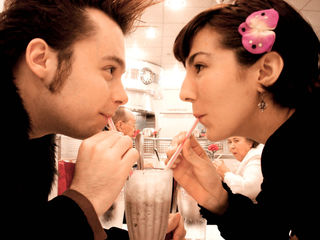Attachment
Love as Attachment
How our love is manifested is a function of our attachment style and personality
Posted December 20, 2016

How our love is manifested is a function of our attachment style and our personality. Psychologist John Bowlby described attachment as an emotional bond that impacts behavior ‘from the cradle to the grave’. How we bond with caregivers during early childhood affects how we behave in relationships, how in touch we are with our emotions and how much we will allow ourselves to love others on a conscious level. The early attachment processes lead to a particular mental model of relationships that continues to shape our interactions with other people as we mature and that predicts how we will interact with romantic partners.
People with a secure attachment style maintain a healthy proximity to other people. They are not afraid of closeness and intimacy, and they do not depend on it in a pathological way. People with an insecure attachment style, on the other hand, avoid closeness with others or their whole existence depends on it.
Attachment theory was first developed as a theory of how children respond to different parental behaviors and how this response pattern affects their relationships later in life. Bowlby argued that in a healthy environment a bonding process occurs between child and caregiver during the first five to six years of the child’s life. The caregiver is in a position to recognize and satisfy the child’s emotional needs. When adequate attachment between child and caregiver is lacking, the child grows up with an impaired ability to trust that the world is a safe place, and that others will take good care of him or her. Childhood abandonment, unpredictable parental behavior, unrealistic parent expectations, and physical, verbal or emotional abuse teach children that their environment is not a safe place and that the people they encounter cannot be trusted.
Children who are abandoned, neglected or mistreated will inevitably experiment with different ways of coping with the psychic wounds and lack of security. Whatever is most effective influences what sort of attachment style they develop. One child may restore some kind of equilibrium by continually seeking the caregiver’s attention and approval. Children in this category develop an anxious/preoccupied attachment style--what is also known as a resistant or ambivalent attachment style. If, however, the initial attempts to restore equilibrium do not work, the child will eventually disengage from the external world and retreat into his or her own mind. They will learn that keeping their thoughts and feelings to themselves leads to the least amount of anguish and pain. Children in this category develop an avoidant attachment style.
The anxious/preoccupied attachment style carries with it a ‘a tendency to make excessive demands on others and to be anxious and clingy when they are not met’ (Bowlby 1973: 14). Anxiously attached individuals are anxious about and preoccupied with long-term commitment and the availability of their partners. They may also continually experience an unfulfilled need for mutuality, intimacy and reciprocity regardless of how available and committed their partner is.
Anxiously attached people furthermore become very anxious when facing separation and during separation from the partner (Hazan & Shaver, 1987). Yet they tend to behave in paradoxical ways upon reunion with the partner or after their needs are met. Their feeling that the partner abandoned them triggers angry protests directed at the partner or angry withdrawal from the partner when the partner eventually attends to them. A similarly negative response can be seen in connection with relationship conflict, which causes the anxiously attached individual to have a more negative attitude toward the partner and the relationship.
Immature, anxiously attached individuals tend to become compulsive care-seekers, wanting their partner to pamper them and take care of them. In successful cases where the care-seeker’s excessive needs are taken care of, this results in a unilateral relationship that provides the care-seeker with support, approval and attention without any expectation that he or she will show any concern or care for the caregiver. If the care-seeking goal is frustrated by a person who purposely or inadvertently fails to take care of the care-seeker’s excessive needs, the care-seeker is likely to lash out with angry insults, passive-aggressive behavior or angry withdrawal from the partner until the partner gives him or her undivided attention and fulfillment of his or her needs.
It is often overlooked that a preoccupied-anxiously attached individual can possess narcissistic traits. However, the preoccupied-anxiously attached care-seeker is an excellent example of an extremely narcissistic person. Conversations will tend to be focused mostly on their needs. Like a child, they will willingly participate in activities only when they are convenient and entertaining for them. Excessive care-seeking can be an underlying cause of attention-seeking disorders like hypochondria, histrionic personality disorder and borderline personality disorder.
Whereas immature anxiously attached individuals are obsessively seeking care, more mature, anxiously attached individuals may become compulsive caregivers, seeking attachment by caring excessively for a parent, child or partner. In this scenario, the anxiously attached person assumes the role of the excessively, caregiving "parent" in order to maintain the illusion of true mutuality and unity: the sublime goal of their existence. When a parent assumes this role in his or her relationship to a child, this can turn into a form of constant hovering over the child, also known as helicopter parenting.
The second type of insecure attachment is the avoidant attachment style. People who are avoidantly attached cannot form close romantic relationships (Bowlby, 1973: 14). They experience fear when they need to narrow down options by committing to another person, a job or a course of action. They furthermore show patterns of compulsive self-reliance, refusing to receive from others or give to others.
Bartholomew & Horowitz (1991) identified two types of avoidant attachment, fearful and dismissive. Whereas the fearfully attached is still hoping to eventually connect with a partner yet fears approaching and connecting and pulls away out of fear, the dismissive avoidant person has given up. They will likely be commitment phobic and use small imperfections in the partner as an excuse for not getting too involved. They may purposely distance themselves from the partner by acting ambivalently, openly flirting with others or cheating, not listening when the partner is talking, not communicating their thoughts or feelings and avoiding intimacy or staying out of touch for days or weeks after an intimate encounter.
The avoidantly attached individual fares slightly better than the anxiously attached individual when faced with relationship conflict. Avoidant people will attempt to avoid conflict, diverting their attention away from the conflict and attachment-related issues. After the conflict, they are likely to behave in less warm and supportive way toward their partner, but unlike their anxious counterpart, they do not view the partner or the relationship in a more negative light.
Attachment is typically viewed as distinct from love. Shaver and Hazan, however, have argued that love is best understood in terms of feelings of attachment or dispositions to have those feelings (Hazan & Shaver, 1987). Attachment, of course, cannot by itself constitute passionate love. Shaver and Hazan adopt a triangular theory of love. Love, they say, is composed of feelings of or dispositions to feel attachment, a desire to engage in caregiving and feelings of or dispositions to feel sexual attraction.
Although there are three components to passionate secure love, the most basic of the three emotions is the feeling of or disposition to feel attachment. The attachment component can involve a multiplicity of other emotions, for instance, euphoria, joy, affection, security, intimacy, trust, fear, anger, resentment, sadness, emotional pain, disappointment and jealousy. The other two components of passionate, secure love are influenced by the individual’s attachment pattern, which in turns influences how the individual feels about attachment.
People who are securely attached tend to be in love relationships that have all three components. Avoidant individuals, by contrast, often do not have the capacity for caregiving. Nor do they show any interest in caregiving. They also fail to associate sexual behavior with intimacy and are more likely to have casual, non-committal sexual relationships than committed relationships.
Anxiously attached individuals score much higher on the caregiving components. They are either compulsive care-seekers or compulsive caregivers or both. Their sexual relationships tend to be a means to satisfy unmet needs for security. They often come across as desperate for love. In their relationships they are likely to be highly jealous and obsessed with their partner as a result of their constant fear of abandonment.
Love understood partially in terms of feelings of attachment has an advantage over numerous other approaches to love. The attachment-theoretical framework forms a unified ‘framework for understanding love, loneliness, and grief at different points in the life cycle’ (Hazan & Shaver, 1987: 511). It furthermore provides a unified account of what distinguishes healthy from unhealthy forms of love. It is noteworthy that the unhealthy forms of love are cases in which the emotions that an individual experiences do not match the object of her love. Compulsive care-seekers, compulsive caregivers and avoidant individuals typically do not have a loving response that matches that of their partners. Compulsive caregivers love too much, whereas compulsive care-seekers and avoidant individuals love too little. So, both kinds of love are unhealthy (or irrational).
Moreover, the love experienced by anxiously attached individuals is very often fueled by an idealization of the beloved. So, the love misrepresents and hence is unhealthy (or irrational) for that reason as well. Of course, one can imagine relationships between, say, two avoidant individuals where the loving responses of each partner match the other person’s loving responses perfectly. This form of love would not strictly speaking be unhealthy and likely is not distressing to the partners. But such cases are merely hypothetical.
Berit "Brit" Brogaard is the author of On Romantic Love and a co-author of The Superhuman Mind.

References
Bartholomew K & Horowitz LM (1991). “Attachment Styles Among Young adults: A Test of a Four-Category Model,” J Pers Soc Psychol. 61 (2): 226–44.
Bowlby, J. (1973), Attachment and Loss, Vol. 2: Separation, Anxiety, and Anger. New York: Basic Books.
Hazan C & Shaver P. (1987). “Romantic Love Conceptualized as an Attachment Process,” J Pers Soc Psychol.52 (3): 511-524.




